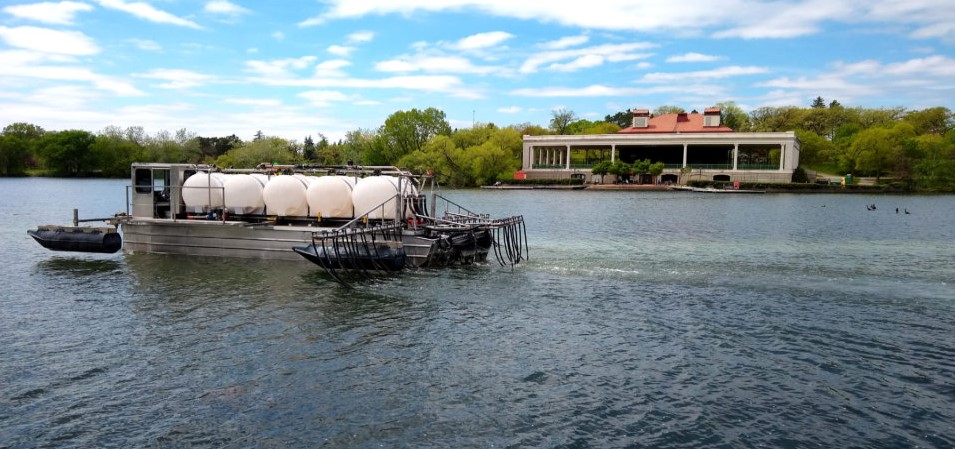Blue Lake Alum Treatment Frequently Asked Questions

Alum treatment being conducted on Como Lake. Image from the Capital Region Watershed District.
What is alum?
Alum (also called aluminum sulfate) is a common mineral found on earth and has historically been used for drinking water treatment and lake management. It is also sold as a spice in most grocery stores and is a common ingredient in pickles.
What does an alum treatment do?
Alum binds with phosphorus making it unavailable for algae. Thus, it greatly reduces the amount of algae growing in a lake. It works by forming a fluffy aluminum hydroxide solid called a floc when applied to water. As the floc settles, it removes phosphorus and particulates (including algae) from the water column. The floc settles on the sediment where it forms a layer that acts as blanket to phosphorus. The phosphorus released from the sediments combines with the alum and is not released into the water.
Why is Blue Lake getting an alum treatment?
Increased land use changes, such as increased development, have impacted the health of Blue Lake. Lake health indicators such as phosphorus and chlorophyll-a suggest that the lake will soon be listed as an impaired waterbody. It is much cheaper to take action to repair lake health now than to wait until the lake is further degraded. Furthermore, a study on Blue Lake (Wenck 2019) found that phosphorus in the lake’s sediments contributes a significant portion of the lake’s total phosphorus. An alum feasibility study was completed in 2020 and found an alum treatment would effectively address the high phosphorus levels in the lake. Both studies can be found at www.isantiswcd.org.
When is it going to happen?
Application will occur over a few consecutive days in the late spring or fall of 2022. A second application will be applied in 2024. Visit www.isantiswcd.org for regular updates.
What will be the benefits?
Alum will address the excess phosphorus found in Blue Lake. Immediately after it has been added to the lake, it binds with phosphorous which removes the opportunity for algae to grow. It also acts as a “blanket” on the bottom of the lake to prevent phosphorus from being released from the sediments. With less algae growing, light can penetrate deeper into the lake. This allows plants to grow at the bottom while improving the overall health and water quality of Blue Lake.
Is it safe for humans? Marine Life? Pets?
Alum is a safe and effective method for lake treatment and will not cause any harm to humans, marine life, or pets. It is a common ingredient in cosmetics, antiperspirants, toothpaste, bath salts and antacids as well as a common lake treatment. Fish caught in Blue Lake will still be safe to eat. In fact, the application of alum often improves fisheries because of better habitat.
What implications will this have for those that use the lake?
The treatment will cause very few disruptions to normal lake activities. At the time of treatment, which should last a few days, access to the lake may be limited. Notices will be posted at accesses as well as online at www.isantiswcd.org. After application, all lake activities may resume as normal. However, boaters should continue to limit their wake around the treatment area. This will make the treatment more effective for a longer period.
Will alum reduce in-lake vegetation (weeds)?
The treatment will not reduce lake vegetation. By reducing algae blooms, in fact, water should be clearer. The increased light penetration could provide the potential for some increased growth of vegetation. A vegetation management plan is being created to be prepared for the possible vegetative response.
How is this being paid for?
The Isanti SWCD was awarded a Clean Water Fund Grant totaling $384,640 to pay for the alum treatment. The Blue Lake Improvement District has dedicated funding to pay for the required 25% match.
Will there be any visual impacts with the water treatment?
No. In fact, Blue Lake’s water clarity should improve immediately once the alum is applied.
Where in the lake will alum be applied?
The alum will only be applied to the deep-water portions of the lake greater than 20 feet deep. This treatment area was identified as the most cost-effective option.
How will the alum be applied?
The application will be done over several days by a professional applicator. The alum will be applied as a liquid under the surface of the water in the designated treatment areas.
